For an individual with mobility concerns, an item as simple as a raised toilet seat can bring greater confidence, increased privacy, independence, all while making the bathroom a safer place.
I have seen how much easier it can make life, with my own elderly mom after her hip replacement at 88 years of age.
But, we didn’t get to where we wanted to be straight away, we first had to navigate a number of failed tryouts with different models of raised toilet seat which were to say the least not very encouraging.
You have to find the model which suits the body and health of the user, and also your toilet and bathroom.
CONTENTS - Overview & Quick Links
What is a raised toilet seat ?
Who should use a raised toilet seat ?
How high should a raised toilet seat be ?
How to measure for a raised toilet seat ?
What is the highest raised toilet seat ?
Raised toilet seats for temporary use
Raised toilet seats for medium term use
- How to install side locking raised toilet seats ?
- How to install Clipper raised toilet seats ?
- How to install front locking raised toilet seats ?
Raised toilet seats for long-term use
- How to install raised toilet seats with legs ?
- How to install Tall, or Spacer, seats ?
- How to install toilet seat risers ?
- How to install a safety frames with raised toilet seats ?
- How to install 3-in1 bedside commodes as raised toilet seats ?
Raised toilet seat features to consider
How to choose a raised toilet seat ?
Raised toilet seat checklist PDF
Where to buy a raised toilet seat ?
Top brands of raised toilet seats
How much does a raised toilet seat cost ?
Does Medicare cover raised toilet seats ?
What is the best raised toilet seat for after hip or knee replacement surgery ?
How to clean raised toilet seats ?
What is a raised toilet seat ?
A raised toilet seat is a device which when attached to, or placed over, a toilet, raises up the height of a toilet seat, to reduce the distance a person has to bend down to sit on a toilet, or to stand up from it.
Certain types of raised toilet seats, which attach to the toilet bowl rim using side fixings, or clamping devices.
Other forms of raised toilet seat do not attach to the toilet seat, but are incorporated into a freestanding frame, which is placed over the bowl of the toilet.
Who should use a raised toilet seat ?
Anybody who suffers with mobility issues, weak legs and hips, or is recovering from hip, or knee replacement surgery, would likely benefit from using a raised toilet seat.
Typically, elderly adults who are frail or suffer from the various problems I noted will use them in some form, or other.
Sufferers of the following health conditions will often benefit from the use of a raised toilet seat –
- arthritis
- spinal conditions
- obesity
- Parkinson’s
- hip replacement surgery
- knee replacement surgery
My mom, who is now in her 90s, eventually decided to use a bedside commode as her raised toilet seat.
The seat is held on a freestanding aluminum frame above the toilet, and as such, cannot detach itself from the toilet, or wobble around.
To our delight, the bedside commode has worked flawlessly as a raised toilet seat, since her surgery over 4 years ago.
As mom has gained in strength, we adjusted the height of the legs for her, slightly lowering it – this is not something you can do on most models which attach to the toilet bowel, as in general they are a fixed height.
You do want to note that there is a wide variety of weight capacities across all the different types of raised toilet seats, so you will want to check, especially if you are buying a seat for a larger person.
To make the task easier for you, I have written a post with the name, product number and weight capacity, of as many raised toilet seats as I could find – “Raised Toilet Seat Weight Capacity: Over 180 Examples”.
How high should a raised toilet seat be ?
A raised toilet seat should be high enough that when sitting, the user’s hip is no lower than the back of their bent knee.
This is especially important if the raised seat is for someone who is recovering from posterior or lateral hip replacement surgery.
If you need to know all about how to sit, and many other precautions to be observed after a posterior or lateral hip replacement surgery, I have a few articles which cover this in depth –
“Do You Need A Raised Toilet Seat After Hip Surgery ? A Guide With Illustrations”, and “How To Sit In A Chair After Hip Replacement: An Illustrated Guide”.
A raised toilet seat should also not be so high, that the user’s feet are left hanging in the air, as the feet may to go to sleep from restricted blood circulation, which can lead to falls when standing up.
To learn more about how to calculate the correct raised toilet seat height, you can check out my post here, – “How High Should A Raised Toilet Seat Be ?”.
Raised toilet seats, which fix to the toilet bowl are available in a range of heights from 1 inch to 6 inches, and freestanding seats, which have adjustable height legs typically have a seat height range from 17 to 23 inches above the floor. Some models have a maximum as high as 27 1/2 inches from the floor.
You will find examples of the different types of raised toilet seats, and their heights, in the post listed above.
How to measure for a raised toilet seat ?
Before you get a raised toilet seat, you will also have to measure your toilet to find out which shape seat you need –
- elongated, or
- standard/round
Some seats only come at the right size for a standard or round shape bowl, and some are only for a larger elongated bowl, and others fit both.
To find out how to make the measurements, you can go to my post here – “How to measure for a raised toilet seat ?”.
What is the highest raised toilet seat ?
The tallest seats which attach to your toilet will give an additional 6 inches to the toilet seat height.
The tallest freestanding raised toilet seat which you place over a toilet is the OasisSpace Stand Alone Safety Frame and Raised Toilet Seat, which has a maximum seat height of 27.5 inches.
3-in-1 bedside commodes can also be used as raised toilet seats, and the tallest of these is the Platinum Health’s GentleBoost Uplift 3-in-1 Commode and shower chair, with a maximum seat height of 25 inches from the floor.
If you are in search of a very high form of toilet seat, raised or otherwise, I would suggest looking this article of mine, which deals specifically with the subject, “What Is The Highest Raised Toilet Seat ?”
While you are looking for raised toilet seats, there is lots more that you can do to make your bathroom a safer place for seniors, or anyone else with mobility issues.
To find out all the different things you can do, to have an instant impact on bathroom safety, take a look here, “54 Bathroom Safety Tips For Seniors – A Helpful Guide”.
Types of raised toilet seat
For an exhaustive look at all the types of raised toilet seats, how they work, fit to the toilet, what advantages each type has, lots of different examples of models, the weight capacities of the different models etc., I have an article here – “Types Of Raised Toilet Seats: All You Should Know Before You Buy”.
The text below is the concise version, with illustrations of the different types of raised toilet seat, and a brief explanation of to whom, the different seats are best suited.
Raised toilet seats for a temporary situation
The two seats below are really only meant to provide a portable solution for when you are not in your own home.
Neither seat is really suitable for anything more than a brief period of use.
There are no armrests on these types of seats, so especially for older users you would want a grab bar on the wall, or a toilet safety frame as well.
The seats have a tendency to wobble, and when we tried some examples, my mom and I found them wholly unsuitable for an elderly adult, let alone one who had recently had a hip replacement.
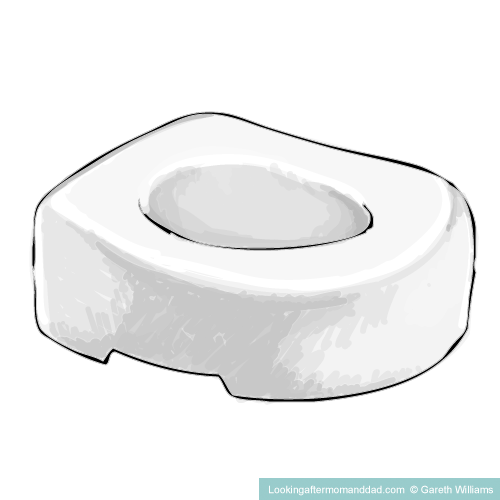
Bubble seats

Clip-On seats
How to install Bubble seats
To install –
- remove your toilet seat and lid
- place the bubble seat over the rim of your toilet and push down hard
- it fits both elongated and standard toilets
The seats –
- are not height adjustable
- have no armrests
- have no bolts, clamps or locks to fix them to the toilet bowl
- have a weight capacity
Examples of this type of seat are –
The NRS Comfort raised toilet seat
Herdegen Contact Plus 5 inch raised toilet seat
Yunga Tart 4 3/4 inch raised toilet seat
Once again without armrests and, in this case, no bolts or fixings to speak of at all, I certainly wouldn’t use this for my elderly loved ones, not even with a safety frame.
How to install Clip On raised toilet seats
To install –
- these seats are designed in a horse shoe shape, with the opening at the front, and clip on to your existing toilet seat
- squeeze the two open ends together
- lower the inner edge of the “clip-on” seat into the opening in of the existing toilet seat
- let go, and the two open ends of the “clip-on” seat spring apart again, and attach to the inner edge of the existing toilet seat
The seats –
- are not height adjustable
- have no armrests
- have no bolts, clamps or locks to fix them to the toilet bowl
- have a weight capacity
Some examples of this are –
Ability Suprtstore 4 inch Clip On Raised Toilet Seat
Performance Health Novelle 4 inch Clip On Raised Toilet Seat
Raised toilet seats for medium term use
The three types of seats below, are more solid and somewhat more solidly secured to the toilet, by various plastic clamping systems, flanges and bolts, but they still are prone to moving around.
Some only fit either an elongated, or a standard shaped toilet, and although a lot of the front locking toilets say they fit all toilet shapes, this is not always true.
But at least the Clipper seats and the Front Locking types of seats can be bought with armrests.
The seats come in ranges of heights from 2 to 6 inches.
I think these seats may be fine for younger users who have a one good leg and no problems with arthritis, balance or any other mobility problems, but I don’t feel good about suggesting them for long-term use by an elderly adult.
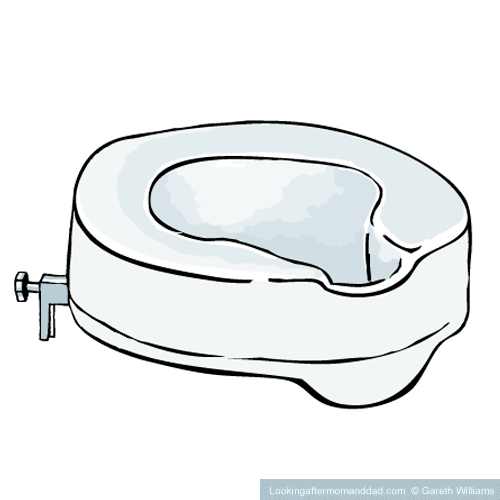
Side fixing raised toilet seats
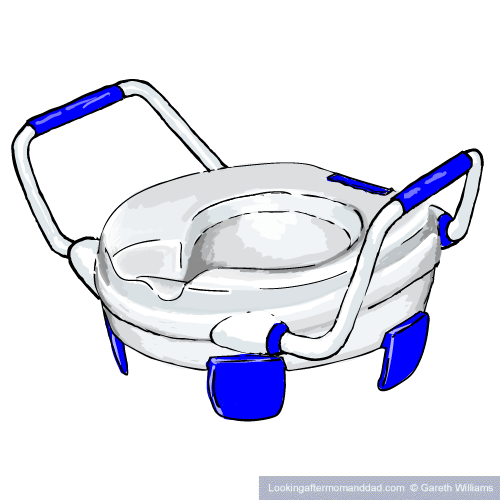
Clipper Seats
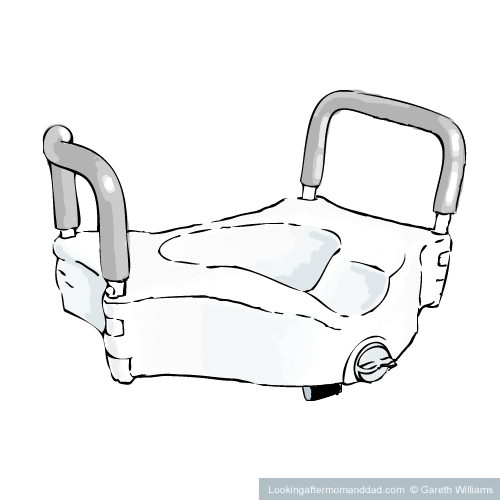
Front locking raised toilet seats
How to install side locking raised toilet seats
To install –
- remove the toilet seat and lid from your toilet
- place the elevated seat over the rim of your toilet bowl
- insert the fixing bolts into the slots on the side and tighten
These seats are –
- bought with or without lids
- not height adjustable
- have no armrests
- standard or elongated
- for different weight capacities
Examples of this system are –
Aquasense 4 inch raised toilet seat with lid
Vaunn Medical Clamp-on 4 inch raised toilet teat
Carex 4 1/2 inch raised toilet seat
Homecraft Savanah 2, 4, 6 inch raised toilet seats with, or without lids
As with all seats without armrests, I would only recommend these for people who have good balance, and wouldn’t use a height that has the user’s feet in the air, or with just the toes touching, as this can lead to a fall when getting up.
I think that a toilet safety frame, or grab bars, again would be a good addition to make it all a bit safer, and to give the person support as they stand up, or sit down.
How to install Clipper seats
To install –
- lift the existing seat and lid into the upright position
- the raised toilet seat placed on the toilet bowl rim
- there is an inner lip which drops several inches into the bowl to stop it wobbling
- there are four plastic clips which are pushed in to grip the outside of the toilet bowl, exerting equal pressure around outside the toilet bowl
- models I, II, III do not have armrests
- models IV and V come with armrests
- VI and VII come with armrests and legs
These seats –
- all made by one brand – Herdegen
- bought with or without lids
- not height adjustable
- have no armrests
- are universally fitting
- have the same weight capacities
The examples of these seats are –
Herdegen Clipper I 4.3 inch raised toilet seat, Prod. No. 500400
Herdegen Clipper II 4.3 inch raised toilet seat, Prod. No. 500410
Herdegen Clipper III 4.3 inch raised toilet seat w/ lid, Prod. No. 500411
Herdegen Clipper IV 4.3 inch raised toilet seat w/ swing-up armrests, Prod. No. 500420
Herdegen Clipper V 4.3 inch raised toilet seat w/ swing-up armrests and a lid, Prod. No. 500421
How to install front locking raised toilet seats
To install –
- remove the existing seat, and lid, from your toilet if it is in your way
- place the seat over the toilet and into the bowl
- guide the back of the seat into the toilet so that the lip at the back goes under the rim of the toilet
- line the seat up to where you would like it
- tighten the knob on the front, and the seat is clamped on to the bowl
The seats –
- most have armrests
- most armrests are removable
- all have their own weight capacities
- are compatible with almost all types of toilet
Some examples of this type –
Carex E-Z Lock 5 inch raised toilet seat with arms
Medokare 4.5 inch raised toilet seat with arms
Vive 5 inch raised toilet seat with padded handle
Drive Medical Premium raised toilet seat with lock and padded armrests
Of all the elevated and raised toilet seats which attach to the toilet with some kind of “clamping” mechanism, the front locking are the more solid.
The fact that they have armrests means that you have something to grab onto before you sit back.
If there was a grab bar next to the toilet as well, I think that this is a good system for all but the most elderly and frail.
The Raised toilet seats for long-term use
The following types of seats have been designed for long-term use, and are well suited to use by an elderly person.
The “Tall Seats” or seats with spacers are very secure as they are bolted to the toilet, but will of course will need some kind of grab bar, or safety rail on the wall.
The toilet plinth, or base riser, may be rather over doing it though, for just a brief period after a hip replacement, if you are not looking to raise the toilet permanently.
Raised toilet seats with legs, safety frames with raised toilet seats, and 3-in-1 commodes are removed from the toilet in seconds, whereas the risers have to unbolted along with the seat and lid, which then have to be put back, which is not the quickest endeavor, especially if you have a guest.
For larger individuals requiring a raised seat a weight capacity of 400 lb, or more, and a lift of more than 2 inches in extra height, have only one option, a bariatric 3-in-1 style bedside commode.
For larger individuals who want to add just 1 or 2 inches, Big John toilet seats (the only other option with a high weight capacity) are a very good choice. But again you will need to install either a safety frame over the toilet as well, or put grab bars up on the wall.
3-in-1 commodes come in a variety of seat widths, aperture sizes, with elongated seats and seat heights, not available in any other form of raised toilet seat.
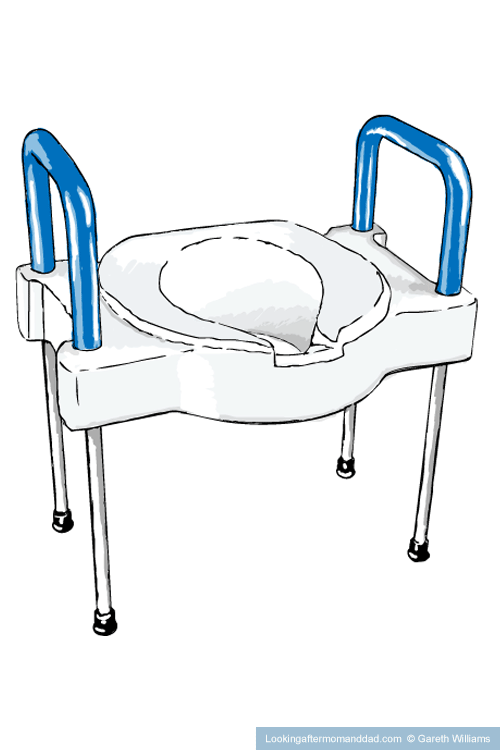
Raised toilet seats with legs
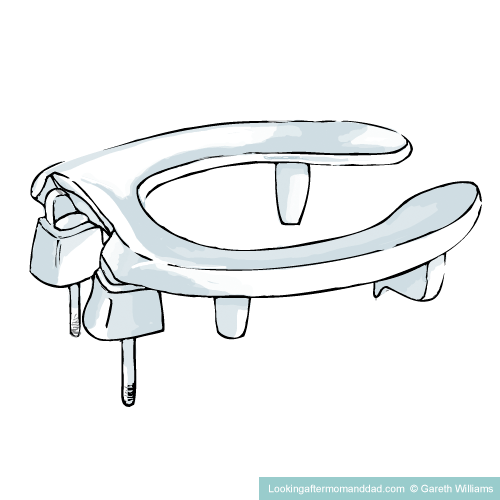
Tall seats
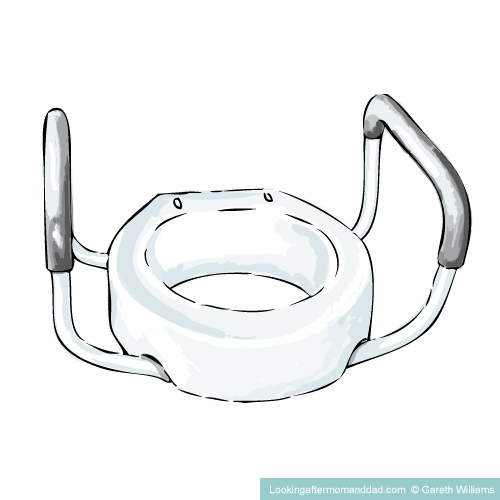
Riser with armrests
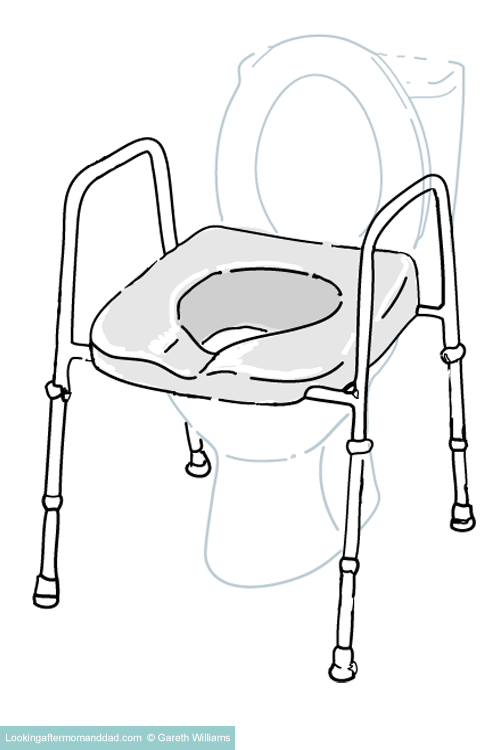
Safety frames with raised toilet seats
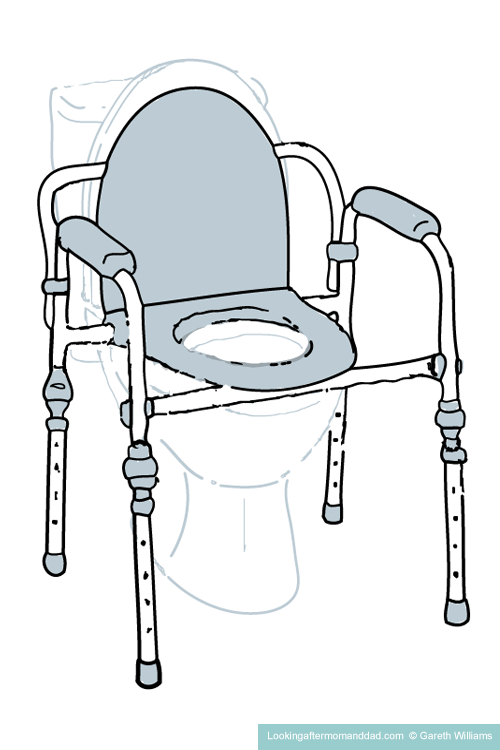
3-in-1 bedside commode
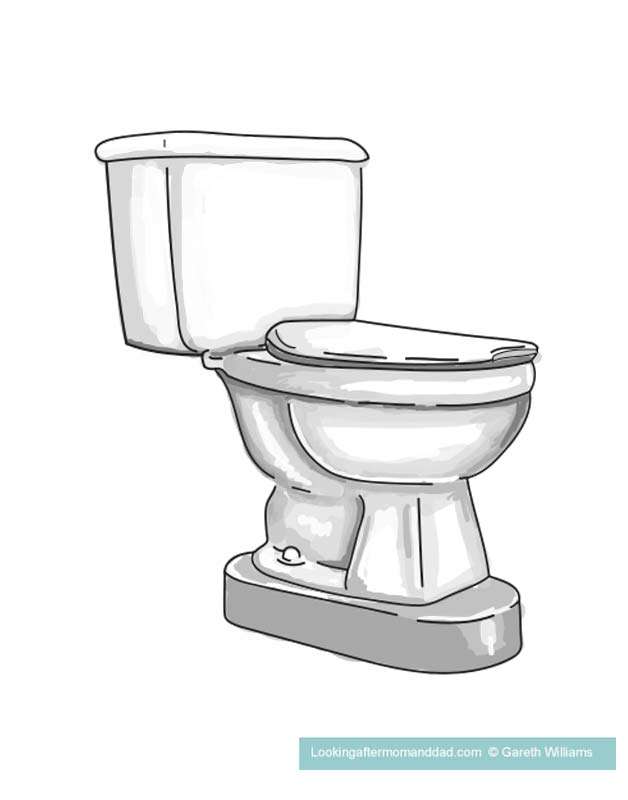
Toilet Plinth or Base
How to install Raised toilet seats with legs
To install –
- the legs have to be adjusted to the height of the toilet bowl
- the seat itself adds about 4 1/2 inches in height to the toilet on most models
- depending on the brand the raised seats may attach differently to the bowl, some just slot in and others slot in and have a front locking bolt, but with four legs there is no real risk of it coming off
- these raised seats can take greater weight than those without legs and are more stable
The seats –
- most have armrests
- most armrests are removable
- all have their own weight capacities
- are compatible with almost all types of toilet
Some examples of raised toilet seats with legs –
Maddak Extra wide Tall-Ette elevated toilet seat w/ aluminum legs, Prod. No. T725881000
Maddak Extra wide Tall-Ette elevated toilet seat with steel legs, Prod. No. T725882000
Mobb 4.5 inchRaised Toilet Seat With Legs Prod. No. MHRTSL
Herdegen Clipper VI 4.3 inch raised toilet seat w/ adjustable frame and armrests, Prod. No. 500430
Herdegen Clipper VII 4.3 inch raised toilet seat w/lid and adjustable frame and armrests, Prod. No. 500431
The armrests are a lot easier for an elderly person to use, and as I have seen with my own mom, when a seat has legs it gives the person more confidence when using it, as there is no problem with the seat moving around.
How to install “Tall Seats” or “Seats with Spacers”
To install –
- remove the existing toilet seat and lid of your toilet
- place the new seat and lid in the same position as the old one
- re-attach the seat with bolts using the toilet bolt holes
The seats are available –
- with or without lids
- in 2 or 3 inch heights
- can be open or closed at the front
- do not have armrests
- the height is not adjustable
- will have weight capacities you will need to check
An example of one of these seats is –
- Centoco 3L440STS-001 raised toilet seat with lid
Due to the lack of armrests, I again wouldn’t suggest these a person who is less than strong, and has good balance, unless you have grab bars, or a toilet safety frame.
How to install toilet risers
To install –
- first remove the seat and lid from your toilet
- align the holes in the riser to the existing bolt holes on your toilet
- place your toilet seat and lid on top of the riser and make sure all the holes line up
- take the new extra long bolts which came with the riser and thread them through and attach the nuts to the bolts on the underside of the toilet
- never over tighten the nuts to the bolts, as the toilet is ceramic and can break
The risers –
- come in a range of heights from different brands of 2 to 4 inches
- can have a hinge to make cleaning easy
- some have armrests
- come as either standard, or elongated, so you will need to know which fits your toilet
Some examples of these risers are –
- Nova 3 1/2 inch toilet seat riser
- Maddak 4 inch hinged seat riser
- Maddak 3 1/2 inch toilet seat riser with safety arms
Risers are extremely solid, and with armrests are a safe option, in my opinion, for people who are quite strong and still have relatively good balance.
How to install safety frames with raised seats
To install –
- put the seat and lid on your toilet in the upright position
- place the frame over your toilet
Safety frames with raised toilet seats –
- the height on all models is adjustable
- the weight capacity is greater than on the plastic clamp on seats
- there are bariatric frames for heavier people
- you can get mechanized frames or toilet lifts which assist in sitting and standing
- all the frames have armrests – they are larger and more sturdy than on the plastic clamp on seats
- the frame takes the weight, not the plastic seat
Some examples of safety frames with raised toilet seats are –
Maddak Tall-Ette elevated toilet seat with legs
PCP raised toilet seat and safety frame 2-in-1
MOBB elevated toilet seat and frame
Aidapt President raised toilet seat and frame
Lattice commode toilet seat and frame
Some examples of toilet lift –
The Uplift Commode
Easy Access Tilt Toilet lift (this model is slightly different as it doesn’t have the frame on the floor, but it is secured to the toilet in a way that it won’t come off)
The Liftseat Powered Toilet Lift
The Drive Solo Lift with Arms
If you are at all worried about the physical capacities of your loved ones and aren’t sure about their balance, strength or mobility, I wouldn’t hesitate to get them a frame with a raised seat, instead of one of the other types.
If you are the caregiver to someone who is very frail, or who has a muscular condition which makes movement extremely difficult, and painful, you may want to look at the toilet lifts.
The first two toilet lifts are a lot more accessible in terms of price, than the latter two, which are very sophisticated and pricey pieces of equipment.
How to install 3-in-1 bedside commodes as a raised toilet seat
To install as a raised toilet seat –
- place the existing toilet seat and lid of your toilet in the upright position
- remove the potty from the commode
- for the tightest fit, remove the backrest
- place the commode over the toilet with its seat on
The 3-in-1 bedside commodes –
- have height adjustable legs
- come with a seat lid
- come with large sturdy armrests
- have bariatric commodes for heavier people
- are also sometimes transfer commodes with wheels
Some examples of this type of commode are –
Drive Medical heavy-duty bariatric commode
Drive Medical steel folding bedside commode
UltraCommode bedside commode
This is pretty much perfect, in my opinion, for an elderly person who needs a bit of assistance with their balance, and who doesn’t have great mobility.
As I said at the outset, I have a post on the topic of using bedside commodes over toilets – “Can A Bedside Commode Be Used Over A Toilet ?”
Features to consider on a raised toilet seat
Height
Finding a seat at a height which is correct for you, or your loved one, so that using it is safe.
Toilet size and shape
Measure your toilet bowl to see which shape it is – elongated, or round toilet – this does not apply to freestanding raised toilet seats.
Weight Capacity
Raised toilet seats have weight capacities anywhere from 250 lb all the way up to over 1000 lb, so make sure you are get the right one.
Portability
Some seats are designed to be used on trips and visits with friends, and which are much more portable. For within the home, the only seats which are not so portable are the heavier bedside commodes, which can weigh up to around 30 lb. So if an elderly, frail adult is going to have to move the seat on and off the toilet, you will need a lighter model.
Fixings
What type of locking system you need, or do you want a freestanding model, this is a real safety issue, and you have to find the most stable model for your situation.
Bolt-on Seats
Bolt on seats – risers and tall seats – are extremely solid and almost as good as a seat with legs, but to get them off takes a few minutes at least, so if you want to take them on and off the toilet, they are not really an option which is very practical.
The downside with “tall seats” is the lack of armrests.
Hinged seats
Some toilet seat risers have hinges which allow you to clean under the seat without unfastening it from the toilet.
Fixed height
Almost all raised toilet seats which attach to the bowl are a fixed height, only several are height adjustable.
Freestanding raised toilet seats
Do you want a model in a frame, which stands over the toilet, which typically has a range of around 17 to 21 inches – bedside commode or safety frame with a raised toilet seat.
Armrests
Some seats come with armrests, which can be of great help to more elderly, frail and visually impaired users.
Armrests with padding
Some armrests come with padding, which are a little comfier than hard plastic.
Seat width
Seats come in a whole range of sizes on the freestanding models, which is good news for those with larger thighs – take a look at the posts listed below.
Elongated Seats
Seats for larger individuals often have elongated seats to help facilitate cleaning – this mainly applies to safety frames with elevated seats and to bedside commodes used as raised toilet seats.
Seat with a front opening
You can get seats on some freestanding models, particularly on bedside commodes, which are open at the front like a horse shoe, which is designed to facilitate personal hygiene.
Padded seats
Some models have seats with padding.
Lids
Some raised toilet seats come with lids.
If you want to know about the weight capacities of the different types of raised toilet seats, you should take a look at my article “Raised Toilet Seat Weight Capacity: Over 180 Examples”
I have three other post for a larger person which will help you to see what models and sizes are available, you can check out each of these articles here –
“Raised Toilet Seats For A Large Person”
How to choose a raised toilet seat?
As well as considering how solid a raised toilet seat is, you also need to consider how secure and stable your elderly loved one is, and also if they will need any extra features to make sitting safer.
To choose which type of raised toilet is suitable for your loved one, you want to consider –
- the space where the seat is going – Clutter ? Access ?
- what is the state of the health of the user
- any particular medical reasons a raised toilet seat is being used + any medications
I have included a free PDF checklist of possible questions that you can download below this section.
Questions you want to ask your self ?
The first two questions you are going to want to ask are –
What weight capacity seat do I need ? If you need a weight capacity which exceeds 600lb, and which is over 3 inches in height, you will have eliminated every seat which attaches to the toilet, and will only have the option of a 3-in-1 bariatric bedside commode.
If you want a weight capacity of over 600lb, and 3 inches is enough of a lift, you have a bariatric “tall seat” made by Bemis, which has a weight capacity of 1000lb, as well as seats by Big John, but these are only 1 or 2 inches tall.
Do I need a really tall raised toilet seat ? In this case, your best options are safety frames and 3-in-1 bedside commodes, unless your toilet is 17 inches or more.
A 17 inch toilet, with a 6 inch seat, will not match the OasisSpace safety frame with raised toilet seat, which has a max seat height of 27 1/2.
I would look at tall toilets if I were very tall, and even a Kohler wall mounted toilet, as there is one model which can be mounted to give a seat height of 28 1/2 inches, and others which give a seat height of 23 inches.
More questions to ask …
The bathroom Space
- how wide is the space ?
- has clutter which may cause a fall been removed ?
- do you need to know how to sit on a raised toilet seat using a walker ? – this can make it much easier for individuals with balance issues, or in post surgery cases where weight-bearing is not allowed on one leg
- is there a need for extra safety equipment to improve confidence about using a raised toilet seat, such as grab bars on the wall ?
The user’s state of health ?
- why do you need a raised toilet seat ?
- how long term will you need a higher seat for ?
- if it’s the short term, do you still need armrests etc. ?
- if the seat is for the long term, do you want to get the most solid seat from the start
- will you need assistance using the raised seat ?
- as well as sitting and standing, are there other mobility issues ?
- how elderly, or frail, is the future user ?
- how good is the user’s balance ? – this will indicate whether they need armrests, and maybe a walker to help them
- is the user’s vision okay, or are there problems ? – if the user is visually impaired, large armrest are a good idea as they may be easier to see
- how strong is the potential user ? – again, this may mean they need decent armrests
- is the user’s grip strong ?
- how good is the person’s coordination ? – seats with big armrests are easier for the elderly
- how confident is your loved one about sitting and standing – are they nervous about using a raised toilet seat ? – the more nervous the user, the more important it is to get a really sturdy model
- how confident are they about moving backwards ? – they may need a walker to help them back up and sit down
- can you make the user more confident with a raised toilet seat ? – a more stable seat with armrests to hold onto will increase a person’s confidence
- is the person able to clean themselves afterwards ? – if not, you may want to buy a drop arm bedside commode which permits side access, or an open front seat, to facilitate personal cleaning
- does the person sit back with quite a jolt ? – if so, you need a solid model on a frame, or a bolted on riser
- is the user a larger person ? If so, do they need a bariatric seat, a wider seat, or an elongated seat, or all three ?
- wide seats for larger thighs ? – you can get either a wider raised toilet seat with legs like the Maddak Tall-Ette, an extra wide bariatric commode, a bariatric safety frame with raised seat.
Medical issues
- are there any medical issues, which will affect your choice ?
- do you need to talk to the doctor or nurse about the seat ?
- does the user suffer from any visual impairments or conditions ? Will they need extra grab bars or bigger armrests ?
- is the seat for a younger person who has had a hip, or knee, replacement, and who has good strength and balance on their good leg ?
- is the seat for an elderly person with a hip, or knee, replacement, and who maybe has poor strength and balance ?
These questions will hopefully help give you the answers you need, and maybe help you to come up with more questions you need to be asking.
Raised Toilet Seat Checklist
You can download and print out your own copy of the Raised Toilet Seat Checklist below for free – no strings attached !
Where to buy raised toilet seats ?
In actual retail stores for raised toilet seats, you can find all types, at large retailers such as –
- Walmart
- Lowes
- Home Depot
- Walgreens
As well as large retail stores, you can find raised toilet seats in specialist medical equipment supply stores, where you will doubtless find more informed staff to help you with your choice.
In my post “Where To Buy A Raised Toilet Seat ?” you will find out which retailers have the widest ranges, the brands they stock, as well as where to buy a 3-in-1 commode if you are covered by Medicare.
The post also tells you how to find cheap or free refurbished raised toilet seats.
Top brands of raised toilet seats
Here’s a list popular brands of raised toilet seats –
- PlatinumHealth
- Drive Medical
- Nova
- Vive
- TFI Healthcare
- OasisSpace
- Bemis
- Centoco
- Maddak
- Lumex
- Mobb
- Medline
- Probasics
- Performance Health
- Guardian
- Graham Field
- Invacare
Raised toilet seats near me ?
It is also very simple to buy the seats online – I got all of mom’s stuff online.
It can be hard to find a lot of the specialist information for raised toilet seats on Amazon, or Walmart, so I have a couple of websites I like to find devices on –
How much does a raised toilet seat cost ?
A raised toilet seat ranges in price from $15.00 to $259.00.
If you want to see a whole range of different types of raised toilet seats and their respective prices, you can check out my post – “How Much Does A Raised Toilet Seat Cost ?”
This price range does not include specialist bariatric commodes, which cost multiple hundreds of dollars.
Does Medicare cover raised toilet seats ?
Medicare Part B does not cover raised toilet seats for use in the home, although they do in certain circumstances cover bedside commodes.
If you want to know about the Medicare guidelines for qualifying for coverage for a bedside commode, you can find that in my post here, “Does Medicare Cover Bedside Commodes ?”.
For those who qualify for a bedside commode under the Medicare guidelines, you use a Medicare-approved Supplier to make your purchase.
To find a Medicare-approved Supplier, just follow this link to their tool, and it will show you the suppliers in your area – Locate A Medicare Approved Supplier
In my post “Where To Buy A Raised Toilet Seat ?” you will find out which retailers have the widest ranges, the brands each one stock, as well as where to buy a 3-in-1 commode if you are covered by Medicare.
The post also tells you how to find cheap or free refurbished raised toilet seats.
What is the best raised toilet seat after a hip replacement ?
There is no one best raised toilet seat for after a hip replacement, the choice that is made depends on the age of the person involved, their size, general health and to a degree their strength.
Elderly adults – based on experiences with my elderly Mom, I would advise using a safety frame with a raised seat, or a portable bedside commode over the toilet.
Younger adults – those without mobility or strength issues, may be able to use some other types of raised toilet seats without putting themselves at risk of a fall – but I would always suggest using armrests.
To learn more on the specific topic of seats for after a hip replacement, I have a post on the subject, “Best Raised Toilet Seats After A Hip Replacement”, in which I outline my preferred toilet raised seats for –
- best raised toilet seats after a hip replacement for an elderly senior
- best raised toilet seats after a hip replacement for a larger elderly senior
- best raised toilet seats after a hip replacement for a younger senior in good shape
- best raised toilet seats after a hip replacement for larger, younger seniors
My post also discusses –
- do you need a raised toilet seat after hip surgery
- how to sit on a raised toilet seat after hip surgery
- for how long would you use a raised toilet seat after hip surgery
- does Medicare cover raised toilet seats
- how to choose your raised toilet seat
It is also a good idea, in the first weeks after the operation, to use a walker in addition to the raised seat.
That way, your parent has something to hold onto when they are standing, and backing up to the toilet, and secondly, they can transfer their weight from the toilet armrests over to the walker.
It is also very important for the person having the surgery, and for their caregiver, to learn how to sit down and to stand up after the surgery. If they can do this properly, it will avoid unfortunate strains, or injuries.
If you want to learn how to sit down and stand up properly from a raised toilet seat or bedside commode with a walker, I have a post which outlines how it should be done, and you can find that here – “Using A Bedside Commode: An Illustrated Guide”.
How to clean raised toilet seats ?
To clean the plastic elevated and raised toilet seats –
- first thoroughly soak the seat in water or with the shower
- use a non-abrasive cleaner to remove any solid waste stuck to the seat
- rinse the seat in warm water
- now wash with disinfectant, and warm water to kill any bacteria, or if you have the time, soak it in a container of bleach for an hour or two
- rinse the seat well and wipe off with a non-abrasive cloth
- if your seat has any grips or plastic parts on any armrest, make sure that it is still firmly in place and doesn’t rotate
- check any fixings, clamps or other locking mechanisms, to make sure that there are no cracks, each time you clean
To clean a frame or commode
- start by removing the seat and lid, soaking them first in hot water, then wash them with an abrasive cleaner, give them a good rinse with warm water, and wash again with a disinfectant, before rinsing with hot water again
- pay particular attention to the armrests and seat, as this is where the body has the most contact
- the underside of the seat, the metal bracket holding the splash guard and the splash guard are the areas which can get soiled the most on a bedside commode, so they have to be thoroughly cleaned
- once you have washed, disinfected and rinsed the parts, you can dry them off with a non-abrasive cloth
- clean the frame in the same way – a little tip here for frames is to put a small piece of electrical tape over all the holes in the legs, to keep water out of the parts which may be corrosive in contact with water, then you can really give it a good soaking before using the cleaner and disinfectant
- and wipe and dry it off
- check that the seat is not cracking anywhere
- clean the plastic parts with a non-abrasive cleaner, or detergent, and warm water
- rinse and wipe off with a non-abrasive cloth
I’m Gareth, the author and owner of Looking After Mom and Dad.com
I have been a caregiver for over 10 yrs and share all my tips here.

